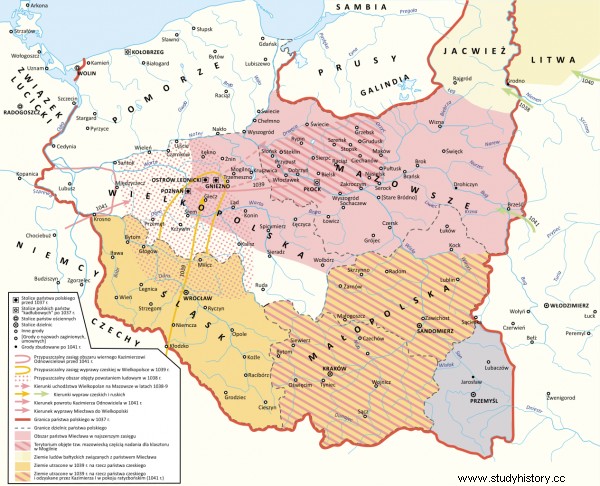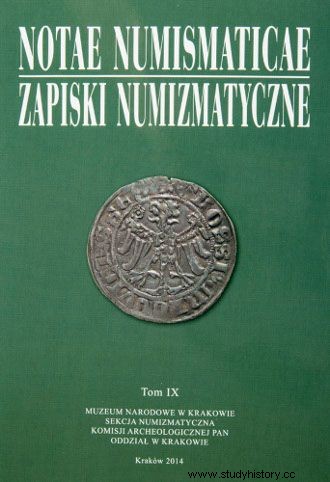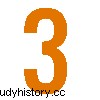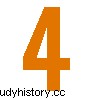He disgraced his master's memory and betrayed the son of the rightful ruler. He put his hand to the collapse of the mighty empire of Bolesław the Brave. And he dreamed of much more. The latest discovery only proves this.
In 1034, the unlucky ruler Mieszko II dies, and his son Kazimierz takes over the power. The young man's reign did not last long. After three years, he has to flee to Hungary. The country is in chaos. Greater Poland is invaded and looted by the Czech prince Brzetysław, a popular uprising breaks out and a pagan reaction. According to Gallus Anonymus, in the churches of Gniezno and Poznań, "wild animals make their lairs".
Confusion bypasses only Mazovia, where one of the close associates of Mieszko II rules - the former teaser Miecław . Refugees from the west and south come to its lands, contributing to the economic development of the district and the growth of the ambitions of its ruler.
When Prince Kazimierz returns to the country, later called the Restorer, Miecław decides to deprive him of the throne and take over the whole of Poland . This was known before. Mateusz Bogucki from the Institute of Archeology and Ethnology of the Polish Academy of Sciences in Warsaw draws attention to a new piece of the puzzle.
According to this scientist, one of the measures aimed at overthrowing the "Natural Lords" was issuing one's own money . Until now, it was believed that after the death of Bolesław the Brave, coins were minted only by Bolesław the Bold. Is the truth different?

At the height of his power, Miecław ruled not only over Mazovia, but also today's Podlasie, Kujawy and eastern Wielkopolska (Fig. Hoodinski, CC BY-SA 3.0).
Mysterious imitations
Among the numismatic items from the 11th century there are numerous so-called imitations, i.e. coins minted according to a popular pattern introduced by someone else. However, these were not forgery, as the purpose was not to deceive - the silver content was not less than in the original. It is often difficult to attribute them to a particular prince or king.
The most common imitations are denarii with the names of Otto and Adelaide, made according to a pattern from Bavaria. Among them, we can distinguish a group of coins found only in Mazovia and most likely from the 1840s . They were all minted with one pair of pistons (obverse and reverse).
A lot of these coins have survived to this day - at least 45! So it must have been a really large-scale action with many thousands of coins being minted. There must have been someone behind the venture who had significant resources of silver. During this period, there was, as we know, only one person in Mazovia who boasted similar wealth. Cześnik Miecław.

The material is based on a scientific article published in the periodical "Zapiski Numizmatyczne".
How to overthrow the Piasts?
Coins attributed by Dr Bogucki to Miecław are distinguished by exceptionally high weight, significantly exceeding the average weight. The scholar believes that Miecław took care of the quality of his denarii, because he wanted to convince his subjects of his own strength and wealth. It was also supposed to be a demonstration against Miecław's allies, such as Pomeranians, who also became independent from the Piast dukes.
In 1047 there was a joint expedition of Kazimierz the Restorer and Jarosław the Wise to Mazovia. Miecław was defeated and probably died in battle. Pomeranians turned out to be loyal allies, perhaps also thanks to the money they received. Unfortunately for themselves and the rebellious cup, they missed the battlefield ...
The source of the above news is:
Mateusz Bogucki, Are there any coins of Miecław, the rebellious teacup of Mieszko II? , "Notae Numismaticae. Zapiski Numizmatyczne, vol. 9 (2014), pp. 135-146.
Historical news. What's the matter?
 | The "historical news" column is the latest news from the world of history. We are looking for missed and concealed discoveries of Polish (and not only) scientists. We show that there is always something going on in research on the past. |
 | Our news is short and accessible. On 2-3 thousand signs, we will summarize for you the discoveries that scientists have made on dozens of pages of hermetic works. We only write about what really matters. No boring. |
 | We rely on scientific publications from the last 18 months . In the world of history, news spreads slowly, and academic works reach potential recipients with a long delay. What in other fields ceases to be news after 24 hours in history may be even a year later. |
 | When preparing news, we follow the list of the most prestigious historical periodicals. If you are a publisher or author and would like us to reach for a specific publication - please send it to our editorial office. |
